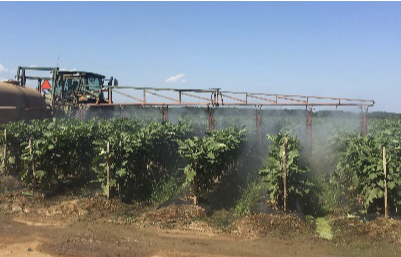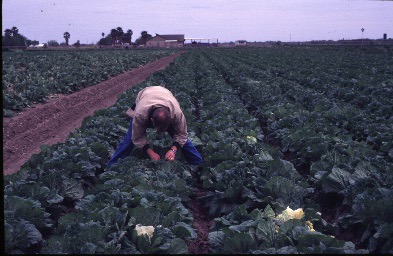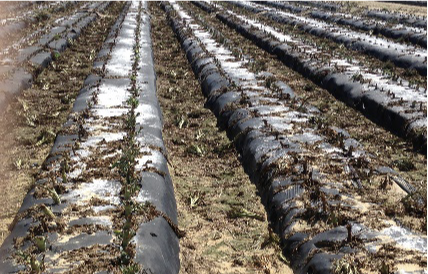The silverleaf whitefly (SLWF), Bemisia tabaci, is an economic pest of numerous crops in Georgia, including cotton and a wide variety of vegetables. Also known as the sweet potato whitefly, immature and adult SLWF (Figure 1) have piercing, sucking mouthparts and damage crops by feeding within vascular tissues and removing plant sap. As they feed, SLWF excrete honeydew, a sticky, sugary solution that accumulates on plants and serves as a food source for sooty mold. Honeydew can cover the plant and block sunlight, resulting in reduced photosynthesis. In cotton, the accumulation of honeydew on lint can have negative impacts on fiber quality and spinning efficiency at mills. In some vegetable crops, SLWF is a vector of viral diseases that can decimate fields, particularly in the fall.


The SLWF has an extremely wide host range and remains active year-round, which makes the Georgia farmscape an ideal location for this pest. Winters are typically mild enough to maintain populations of SLWF on cultivated crops and winter weeds that serve as host plants. Populations of SLWF can increase rapidly, as females lay 150 to 200 eggs at a time, and a generation can be completed in less than 20 days during the heat of the summer. In general, populations of SLWF move from winter vegetables to spring vegetables, to agronomic crops, to fall vegetables, and then back to winter vegetables (Figure 2). Management of SLWF in these individual cropping systems affects infestations in subsequent crops as SLWF move from one cropping system to the next. Failing to properly manage SLWF in any one of these systems can have negative consequences for subsequent cropping systems.

Primary Cropping Systems That Drive Populations of Silverleaf Whitefly in Georgia

-
Winter vegetables: Important cultivated winter hosts include cabbage, collards, kale, and related crops. Populations of SLWF are usually low at the end of winter but can maintain pest status on these crops during mild winters.
-
Spring vegetables: Primary spring hosts include cucurbits (cantaloupe and cucumbers are excellent hosts; watermelons are less preferred but can support large populations; squash supports lower populations but is very sensitive to feeding) and fruiting vegetables (mostly tomato and eggplant). In most years, populations in the spring are low and do not require management with insecticides. After mild winters, however, SLWF may require treatment in spring vegetables, and these early populations provide the basis for unmanageable problems later in the year.
-
Agronomic crops: Cotton is a preferred host for SLWF and can support very large populations. Economic infestations are typically localized and require management with insecticides during some years. Late-planted cotton and varieties with characteristically hairy leaves are at the highest risk of developing infestations of SLWF. A late-planted soybean crop is also a good host for SLWF.
-
Fall vegetables: Populations of SLWF are typically highest during the fall and can produce overwhelming problems during outbreak years. When populations are large, and viruses transmitted by SLWF are present, production of fall crops that are susceptible to those viruses may be uneconomical or impractical.
Environmental factors influencing populations of SLWF. Tropical systems and freezes impact the potential for problems with SLWF. Winter freezes can kill adult SLWF, but freezes likely have minimal impact on eggs and immature SLWF in Georgia. Hard freezes do eliminate host plants (cultivated crops and weed hosts) that are not cold- tolerant, thus leading to lower populations surviving the winter. While localized rainfall and irrigation has minimal effects on populations of SLWF, tropical systems produce heavy rains across large areas that result in high mortality of adults. Unfortunately, heavy rains have minimal impact on immature SLWF. The timing of these rainfall events can impact the overall population. For example, a tropical system moving through the area as SLWF are dispersing from one crop system to another is likely to have greater impact than when they are cycling within a crop.
Minimize buildup of SLWF population in all cropping systems. Integrated pest management (IPM) of SLWF includes in-season and postharvest management. Early detection of SLWF is critical for successful management, as appropriate insecticides must be applied early in the development of populations. Postharvest management includes destroying host crops immediately after the final harvest to eliminate additional population growth of SLWF. In vegetables, this could be physical or chemical termination. Similarly, cotton requires timely defoliation and harvest to suppress the population growth of SLWF. Effective cross-commodity management reduces overall populations and intercrop movement. When all agricultural entities employ effective programs to manage SLWF, all growers benefit.
Management considerations for SLWF. The objectives of IPM programs address SLWF as a direct pest in crops and aim to minimize overall populations across the farmscape. The three most important activities of growers in managing populations of SLWF include:
-
Timing and location of plantings: Growers should spatially separate sequential plantings
of preferred SLWF hosts as much as possible. While this is not practical with cotton due to
the large acreage involved, sequential plantings of winter crops and spring vegetables should be separated whenever possible. If it is unavoidable to plant adjacent to an infested crop, consider the increased potential for infestations of SLWF, and manage proactively. -
Timely in-season control of SLWF: Although several insecticides are efficacious against SLWF, most are active on immature stages and provide little or no control of adults. For this reason, it is difficult to rescue a crop once a SLWF population is established. Crops must be monitored closely and control measures implemented early (Figure 3) when established thresholds are met.
-
Complete destruction of host crops after harvest: Crops that maintain green foliage after final harvest can allow for rapid population increases of SLWF. These crops should be rendered as nonhosts as soon as possible after harvest, either through mechanical or chemical termination (Figure 4). Even after chemical burndown of infested crops, large nymphs (third and fourth instars) are likely to complete development. It is preferable to disk the crop immediately after final harvest.




Options for control with insecticides. The proper selection of insecticides will vary with the crop and situation, and understanding the target life stage and mode of action will help in designing the optimal control program. Crop-by- crop options for insecticides, recommended by University of Georgia Cooperative Extension, can be found in the Georgia Pest Management Handbook. To reduce the potential for resistance, rotate the insecticide classes used for SLWF control, as SLWF have developed severe resistance to some insecticides. The presence of SLWF in a crop should also influence insecticide decisions for other pests; for example, growers should avoid broad-spectrum insecticides that cause SLWF to flare.
Cropping System Recommendations
Cole crops (particularly winter crops): Delay fall plantings as much as possible to avoid peak populations of SLWF. Consider at-planting preventative applications of a systemic insecticide if SLWF are a known issue in your area. Separate later plantings from early plantings as much as possible. A 5-mile separation may not completely deter infestation, but even a half of a mile should reduce movement from field to field. Although winter cole crops may not harbor enough SLWF to present an economic threat to the crop, SLWF overwinter in these crops. Therefore, it is critical that these crops are destroyed as soon as possible after harvest. In many cole crops, SLWF nymphs appear in the greatest numbers on the oldest leaves. For crops in which leaves are stripped for harvest, recent field surveys suggest that removing all old leaves will reduce populations of SLWF within a field.
Spring vegetables: Separate, temporally and spatially, spring plantings from winter cole crops as much as possible. While spring vegetables do not frequently harbor damaging levels of SLWF, they are the source of populations that move into cotton and, ultimately, fall vegetables. Whether SLWF have reached damaging levels or are barely detectable, these crops should be terminated as soon as possible after harvest. Favorable hosts, particularly some cucurbit crops, can produce huge populations of SLWF in a very short time in the early summer.
Cotton: While other crops grown in the summer play a role in producing populations of SLWF, cotton is the preferred summer host with the largest acreage in Georgia. All efforts should be made to minimize the risk and potential need for insecticide application for SLWF in cotton. Varieties with hairy leaves support significantly larger populations of SLWF compared with smooth-leaf varieties. Furthermore, risk for developing populations of SLWF in cotton increases with later planting of the crop. It is critically important that insecticide applications are well timed. Insect growth regulators are the primary insecticide tools for managing SLWF in cotton. If high populations become established prior to treatment, faster-acting chemistries and more frequent applications will be necessary. Principles and practices of IPM, including the conservation of beneficial insects, should be implemented to the greatest extent possible. Defoliation and harvesting the crop as soon as it is ready will minimize open bolls being exposed to honeydew and eliminate any additional increase in SLWF populations within the field.
Fall vegetables: In years with outbreaks of SLWF, location may be irrelevant in much of Georgia. For more normal years, management needs will vary by location and potential for problems with SLWF. Systemic insecticides used at planting are recommended in areas with a history of infestations or evidence of significant populations of SLWF in cotton. In these areas, scheduled applications are often necessary because of the constant immigration of adults into crops. This also makes the evaluation of spray programs difficult. Most insecticides used for control of SLWF provide only suppression or no control of adults. The evaluation of treatment programs and the frequency of insecticide applications should be based on nymph populations; even the most successful programs will leave adults in the field. As with all other crops, fall vegetables should be destroyed once the crop is no longer being managed. This will reduce movement into winter crops. Although the SLWF life cycle slows during cooler weather, it does not stop.
Summary
Silverleaf whitefly (SLWF) is an important economic pest that requires management in vegetable and agronomic cropping systems to preserve yield and quality. The best opportunity to reduce the severity of infestations is to minimize SLWF populations moving from one cropping system to another. This can be accomplished with effective in-crop management and timely crop termination after harvest to minimize population development. SLWF populations increase during the year, and management within each cropping system significantly impacts subsequent cropping systems. It is important to prioritize SLWF management in all agronomic and horticultural crops. Cross-commodity cooperation and management with the objective of minimizing overall populations of SLWF will benefit all Georgia growers.
Status and Revision History
Published on Aug 02, 2018


























































